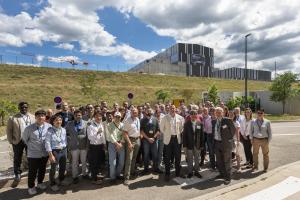A shared vision to prepare for delivery
A summit organized at ITER Headquarters from 3 to 6 June brought together the international teams that will deliver the sub-systems of the ITER Tritium Plant.
If the keyword at the 2023 Tritium Plant Summit was "standardize," in 2024 it was "delivery."
With 70 team members from the ITER Organization and the Domestic Agencies attending in person, and a further 30 connected remotely, the Council Room provided an inspiring setting for the type of international collaboration that makes the ITER Project unique.
The mission statement for the 2024 Summit was to continue to develop a shared vision and culture to successfully deliver the Tritium Plant project on time and on budget.
With this aim in mind, the stated goals were to:
- Share lessons learned from design to construction
- Agree on standardization to help identify opportunities to accelerate delivery
- Work collaboratively on technical challenges to develop plant-wide solutions
- Identify areas of common work to avoid duplicated effort to save costs
The next five years are critical for delivery of the tokamak exhaust system (US ITER), the tritium storage and delivery system (ITER Korea), the air detritiation system (ITER Japan/ITER Organization), and the isotope separation and water detritiation systems (Fusion for Energy, Europe) that make up the Tritium Plant. Although at different levels of maturity, all Domestic Agencies are gearing up to deliver their systems through a series of gate reviews that will culminate in the physical realization of years of research and design.
In the near term, the ITER Tritium Plant project central team is gaining valuable experience working in partnership with industry to deliver the condensing and filtration skid and the first exhaust system, which are required for ITER's first research phase (called the Start of Research Operations, SRO) and to support commissioning of Tritium Plant systems.
Subsequently, discussions focused on practical and logistical aspects associated with manufacturing quality control, the availability of vendors, assembly, transport and installation. The range of challenges is significant—from the implementation of quality requirements for procurement of proven-in-use commercial off-the-shelf components, to shipment and installation of four-metre-long glovebox modules, to inspectability of complex unit operations inside vacuum jackets.
A wealth of experience with the design, fabrication, operation, maintenance and decommissioning of tritium facilities was concentrated at the summit—including representatives from the Tritium Process Laboratory in Japan, the Savannah River National Laboratory in the United States, and the DU SPOVE in South Korea—which meant the right people were in the room to find solutions to tritium-specific design considerations. The recent experiences of the European Domestic Agency, Fusion for Energy, in designing and installing the ITER cryoplant also provided valuable lessons learned for working with the supply chain.
The updated ITER Baseline was of key importance to discussions; notable impacts to the Tritium Plant include changes to the throughput and the implementation of a boronization process for the tungsten wall.
Standardization remains critical to achieving project aims, not only standardization in technical terms such as equipment selection, technical specifications, interpretation and application of local regulations, but also in organizational terms such as adopting common ways of working.
There are many benefits to standardization that will be realized throughout the ITER lifecycle, such as producing consistent and compatible design documents, harmonizing procurement activities, optimizing qualification efforts, enabling fewer spare components, and ensuring consistent maintenance work—all of which will contribute to streamline delivery and operation of the Tritium Plant.
It is an objective that appears simple at first glance, but with each Domestic Agency having its own experience with tritium technologies and local supply chains to develop, a conscious effort by all teams, coordinated by the ITER Organization, is needed to maximize the implementation of standard solutions.
An evening meal in Vinon, and possibly the most international pétanque tournament ever assembled, ensured that colleagues were able to share experiences and ideas in a more informal setting.
Overall, the 2024 Summit provided a timely opportunity to refocus on shared objectives. Participants agreed that delivery of the Tritium Plant will be founded on continuous wide-ranging collaboration in between summits, while these periodic in-person events remain essential to maintaining the working relationships and informal contact that lubricate the wheels of success.




